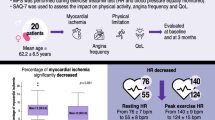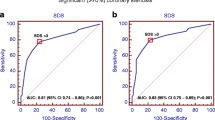Summary
The purpose of the present study is to assess the effect of nicorandil, a coronary vasodilator with a mechanism of potassium channel opening, on the abnormal myocardial201Tl perfusion evoked by exercise. Eleven patients who had a history of typical angina, positive exercise electrocardiograms, positive201Tl scintigraphy, nearly normal coronary arteriograms, and negative coronary vasospasm underwent exercise201Tl scintigraphies under no medication (baseline test) and administration of nicorandil (nicorandil test).201Tl was injected at a matched workload in both tests. Nicorandil did not alter heart rate, blood pressure, or the rate-pressure product at the end of the exercise, but it significantly improved the extent score from 0.37±0.22 to 0.20±0.15 (p<0.05) and the severity score from 33.9±32.2 to 13.5±16.4 (p<0.05), and also significantly hastened the201Tl mean washout rate from 30.5±14.8% to 37.4±13.1% (p<0.05). Anginal symptoms disappeared in 3 of 5 cases and ST depression improved in 5 of 7 cases after nicorandil. We conclude that nicorandil augments coronary flow reserve, possibly due to a reduction of vasotone in the small coronary arteries.
Similar content being viewed by others
References
Canon RO, Schenke WH, Leon MB, et al. Limited flow reserve after dipyridamole in patients with ergonovine-induced coronary vasoconstriction.Circulation 1987;75:163–174.
Legrand V, Hodgson J McB, Bates ER, et al. Abnormal coronary flow reserve in patients with normal coronary angiograms.J Am Coll Cardiol 1985;6:1245–1251.
Korhola O, Valle M, Frick MH, et al. Regional myocardial perfusion abnormalities on xenon-133 imaging in patients with angina pectoris and normal coronary arteries.Am J Cardiol 1977;39:355–359.
Epstein SE, Canon RO. Site of increased resistance to coronary flow in patients with angina pectoris and normal epicoronary arteries.J Am Coll Cardiol 1986;8:459–461.
Maseri A, Crea F, Kaski JC, et al. Mechanism of angina pectoris in syndrome X.J Am Coll Cardiol 1991;17:499–506.
Romeo F, Gaspardone A, Ciavolella M, et al. Verapamil versus acebutolol for syndrome X.Am J Cardiol 1988;62:312–313.
Cannon RO, Watson RM, Rosing DR, et al. Efficacy of calcium channel blocker therapy for angina pectoris resulting from small vessel coronary artery disease and abnormal vasodilator reserve.Am J Cardiol 1985;56:242–246.
Montorsi P, Manfudi M, Loaldi A, et al. Comparison of coronary vasomotor response to nifedipine in syndrome X and Prinzmetal's angina pectoris.Am J Cardiol 1989;63:1198–1202.
Burgiardini R, Boghi A, Biagetti L, et al. Comparison of verapamil versus propranolol therapy in syndrome X.Am J Cardiol 1989;63:286–290.
Radice M, Giudici V, Albertini A, et al. Usefulness of change in exercise tolerance induced by nitroglycerin in identifying patients with syndrome X.Am Heart J 1994;127:531–535.
Galassi A, Kaski JC, Pupita G, et al. Lack of evidence for alpha-adrenergic receptor-mediated mechanisms in the genesis of ischemia in syndrome X.Am J Cardiol 1989;64:264–269.
Kinoshita M, Sakai K. Pharmacology and therapeutic of Nicorandil.Cardiovasc Drugs Ther 1990;4:1075–1088.
Furukawa K, Itoh T, Kajiwara M, et al. Vasodilating actions of 2-nicotinamidoethyl nitrate on porcine and guinea-pig coronary arteries.J Pharmacol Exp Ther 1981;218:248–259.
Yoneyama F, Satoh K, Taira N. Nicorandil increases coronary blood flow predominantly by K-channel opening mechanism.Drugs Ther 1990;4:1119–1126.
Camici PG, Marraccini P, Lorenzoni R, et al. Coronary hemodynamics and myocardial metabolism in patients with syndrome X: Response to pacing stress.J Am Coll Cardiol 1991;17:1461–1470.
Cannon RO, Epstein S. “Microvascular angina” as a cause of chest pain with angiographically normal coronary arteries.Am J Cardiol 1988;61:1338–1343.
Reaven GM. Role of insulin resistance in human disease.Diabetes 1988;37:1595–1607.
Dean JD, Jones CJH, Hutchison ST, et al. Hyperinsulinemia and microvascular angina.Lancet 1991;23:456–457.
Ley CJ, Swan J, Godsland IF, et al. Insulin resistance, lipoproteins, body fat and hemostasis in nonobese men with angina and a normal or abnormal coronary angiogram.J Am Coll Cardiol 1994;23:377–383.
Waldenstrom A, Ronquist G, Lagerqvist B. Angina pectoris with normal coronary angiograms but abnormal thallium perfusion scan exhibit low myocardial and skeletal muscle energy charge.J Int Med 1992;231:327–331.
Canon RO, Bonow RO, Bacharach SL, et al. Left ventricular dysfunction in patients with angina pectoris, normal epicardial coronary arteries and abnormal vasodilator reserve.Circulation 1985;71:218–226.
Jackson G, Atkinson L, Armstrong P, et al. Angina with normal coronary arteriograms: Value of coronary sinus lactate estimation in diagnosis and treatment.Br Heart J 1978;40:976–978.
Opherk D, Zebe H, Weihe E, et al. Reduced coronary dilatory capacity and ultrastructural changes of the myocardium in patients with angina pectoris but normal coronary arteriograms.Circulation 1981;4:817–825.
Crake T, Canepa-Anson R, Shapiro LM, et al. Continuous recording of coronary sinus saturation during atrial pacing in patients with angina pectoris with or without coronary artery disease or with syndrome X.Br Heart J 1987;57:67–72.
Levy RD, Shapiro LM, Wright C, et al. Diurnal variation in left ventricular function: A study of patients with myocardial ischemia, syndrome X, and of normal controls.Br Heart J 1987;57:148–153.
Picano E, Lattanzi F, Masini M, et al. Usefulness of a high dose dipyridamole-echocardiography test for diagnosis of syndrome X.Am J Cardiol 1987;60:508–512.
Moseri M, Yarom R, Gotsman MS, et al. Histologic evidence for small-vessel coronary artery disease in patients with angina pectoris and patent large coronary arteries.Circulation 1986;74:964–972.
Berger BC, Abramowitz R, Park CH, et al. Abnormal thallium-201 scans in patients with chest pain and angiographically normal coronary arteries.Am J Cardiol 1983;52:365–370.
Green LH, Cohn PF, Holman BL, et al. Regional myocardial blood flow in patients with chest pain syndromes and normal coronary arteriograms.Br Heart J 1978;40:242–249.
Tweddel AC, Martin W, Hutton I. Thallium scans in syndrome X.Br Heart J 1992;68:48–50.
Gassasi AR, Crea F, Arajio LI, et al. Comparison of regional myocardial blood flow in syndrome X and one vessel coronary disease.Am J Cardiol 1993;72:134–139.
Epstein SE, Cannon RO, Bonow RO, et al. Exercise testing in patients with microvascular angina.Circulation 1991;83(Suppl III):III73-III76.
Sax FL, Cannon RO, Anson C, et al. Impaired forearm vasodilator reserve in patients with microvascular angina: Evidence of a generalized disorder of a vascular function?N Engl J Med 1987;317:1366–1370.
Egashira K, Inou T, Hirooka Y, et al. Evidence of impaired endothelium-dependent coronary vasodilatation in patients with angina pectoris and normal coronary angiograms.N Engl J Med 1993;328:1659–1664.
Quyyumi AA, Cannon RO, Panza JA, et al. Endothelial dysfunction in patients with chest pain and normal coronary arteries.Circulation 1992;86:1864–1871.
Emdin M, Picano E, Lattanzi F, et al. Improved exercise capacity with acute aminophylline administration in patients with syndrome X.J Am Coll Cardiol 1989;14:1450–1453.
Bugiardini R, Pozzati A, Puddu P, et al. Vasotonic angina: A spectrum of ischemic syndromes involving functional abnormalities of the epicardial and microvascular coronary circulation.Am J Coll Cardiol 1993;22:417–425.
Kato K. Hemodynamic and clinical effects of an intravenous potassium channel opener—a review.Eur Heart J 14(Suppl B):40–47, 1993.
Satoh K, Yanagisawa T, Taira N, et al. Effect of 2-nicotinamidethyl nitrate (SG-35) on membrane potentials of canine Purkinje fiber (summary in English).Jpn J Pharmacol 31:409–417, 1981.
Yamazaki J, Ohsawa H, Uchi T, et al. Study of the efficacy of nicorandil in patients with ischemic heart disease using exercise201Tl myocardial tomography.Eur J Clin Pharmacol 1993;44:211–217.
Kinoshita M, Nishikawa S, Sawamura M, et al. Comparative efficacy of high-dose versus low-dose nicorandil therapy for chronic stable angina pectoris.Am J Cardiol 1986;58:733–738.
Holzmann S. Cyclic GMP as possible mediator of coronary arterial relaxation by nicorandil.J Cardiovasc Pharmacol 1983;5:364–370.
Satoh K, Yamada H, Taira N. Differential antagonism by glibenclamide of the relaxant effects of cromakalim pinacidil and nicorandil on canine large coronary arteries.Naunyn Schmiedebergs Arch Pharmacol 1991;10(Suppl. 8):S17-S24.
Cavero I, Pratz J, Mondot S. K channel opening mediates the vasorelaxant effects of nicorandil in the intact vascular system.Zeitschrift Kardiol 1991;80(Suppl. 7):35–41.
Berdeaux A, Drieu la Rochelle C, Richard V, et al. Differential effects of nitrovasodilators, potassium channel openers and nicorandil on large and small coronary arteries in consciousness dogs.J Cardiovasc Pharmacol 1985;7:1107–1112.
Onishi M, Maeda K, Fukuzaki H. Antianginal mechanism of nicorandil: Study on exercise invasive hemodynamics and thallium-201 myocardial perfusion images (summary in English).Angiology 1987;27:191–195.
Brush JE, Canon RO, Schenke WH, et al. Angina due to coronary microvascular disease in hypertensive patients without left ventricular hypertrophy.N Engl J Med 1988;319:1302–1307.
Scheler S, Motz W, Struer BE. Mechanism of angina pectoris in patients with systemic hypertension and normal epicardial coronary arteries by arteriogram.Am J Cardiol 1994;73:478–482.
Koistinen MJ, Huikuri H, Pirttiaho H, et al. Evaluation of exercise electrocardiography and thallium tomographic imaging in detecting asymptomatic coronary artery disease in diabetic patients.Br Heart J 1990;63:7–11.
Author information
Authors and Affiliations
Rights and permissions
About this article
Cite this article
Yamabe, H., Namura, H., Yano, T. et al. Effect of nicorandil on abnormal coronary flow reserve assessed by exercise201Tl scintigraphy in patients with angina pectoris and nearly normal coronary arteriograms. Cardiovasc Drug Ther 9, 755–761 (1995). https://doi.org/10.1007/BF00879868
Received:
Accepted:
Issue Date:
DOI: https://doi.org/10.1007/BF00879868




